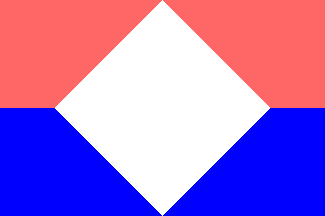
by Jairo Alonso Méndez Méndez, 16 April 2004

Last modified: 2004-12-31 by dov gutterman
Keywords: cundinamarca | colombia | guayabetal | guava | oriente |
Links: FOTW homepage |
search |
disclaimer and copyright |
write us |
mirrors

by Jairo Alonso Méndez Méndez, 16 April 2004
See also:
The flag of Guayabetal (Oriente Province, Cundinamarca). Only
this municipality and Guayabal de
Síquima have a "guava" color in its flags. The
"guava" is a light red, in RGB scale is 255-96-96. In
spanish it means "guayaba" and is a fruit of hot and
medium weathers.
Jairo Alonso Méndez Méndez, 16 April 2004
Both the tree and the edible fruit are called
"guava" in English. In French and Dutch, the difference
between the tree and the fruit is expressed ("goyavier"
and "goyave", "guaveboom" and
"guave", respectively).
"Guava" is the name given to the fruit by the Caribbean
natives. The Spaniards transformed it in to "guayaba",
which gave the French "goyave" via "goulave".
The guava (Psidium guyava) belongs to genus Psidium, family
Myrtaceae, order Myrtales. The members of the Myrtaceae are
aromatical trees or shrubs. Most of them are tropical, except the
myrtle (Myrtus communis) which has survived in the Mediterranean
areas. Among the Myrtales of economical interest are the clove
tree (Syzygium aromaticum), the niauli tree (Melaleuca
virdiflora), the all-spice tree (Pimenia acris), and the
Eucalyptus. There is in Africa a wild tree whose non-edible fruit
look like guavas, called "goyavier de brousse" (brush
guava).
Sources: Grand Robert de la Langue Francaise;
Encyclopaedia Universalis.
Ivan Sache, 17 April 2004
From <www.cundinamarca.gov.co>:
"Compuesta por dos franjas iguales en colores guayaba, y
azul, en el centro un rombo blanco y sobre este el escudo
municipal.
El color guayaba, hace alusión a la fruta del árbol de guayabo,
se dice que este concepto es una de las razones por las cuales el
municipio lleva este nombre, o también por el árbol de
Guayabeto.
La segunda franja de color azul, simboliza la riqueza hídrica
del municipio.
El color blanco del rombo que enmarca el centro, representa, la
raíz de la planta de Sagú de donde se extrae un almidón que
sus habitantes comercializan, siendo esto base de la economía
del lugar."
Felipe Carrillo, 20 November 2004
cungb.gif)
by Carlos Thompson, 28 December 2004